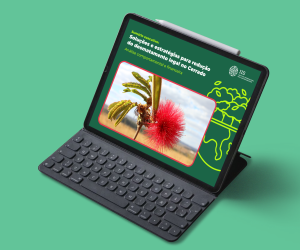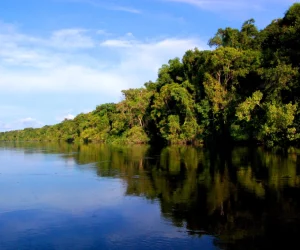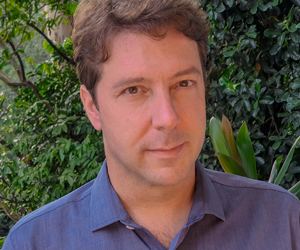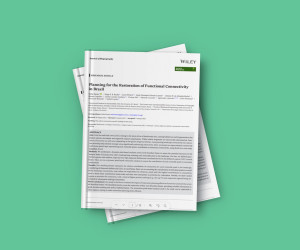News > News
04.05.15
New study shows that forest restoration cana chieve large scale without competing with agriculture
In the article published in Frontiers in Ecology and the Environment, researchers show that the solution is to increase in a sustainable way the productivity of pastures
Reconciling agricultural expansion with conservation and ecological restoration at large scale is a possible according to the researchers from the International Institute for Sustainability from Rio de Janeiro (IIS).
Although reconciling environmental protection and development is internationally recognized as one of the greatest, if not the greatest, challenge to sustainability in the coming decades, a scientific paper, published on the 1st of May 2015, in the American journal Frontiers in Ecology and the Environment, authored by Agnieszka Latawiec (research director at IIS), Bernardo Strassburg (executive director of the IIS), Pedro Brancalion and Ricardo Rodrigues (University of São Paulo) and Toby Gardner (IIS and Stockholm Environment Centre) shows that, with appropriate planning, it is feasible to accommodate both forest expansion at large scale and the increase of agricultural production without needing to expand into new, often pristine, areas.
“We have now some two billion hectares of deforested and degraded lands worldwide. We need to reverse this trend. There are many people claiming that reconciliation of increasing agricultural output and large-scale restoration is not possible. We proved that this is not the case” says Agnieszka.
According to the article, the key is to increase pasture productivity in a sustainable way. It is necessary to invest in increased production techniques, in order to maintain local productivity and spare land for reforestation. For appropriate planning it is crucial to identify the right areas to be restored and those with a high potential for agriculture and livestock, explains Agnieszka.
This idea, now brought to the international community is the goal of IIS, which, in collaboration with various national and international organizations, coordinates or participates in about ten projects looking into restoration. In particular, IIS is already discussing with several organizations how to best restore forest in the state of Rio de Janeiro with the least possible economic interference.
In the article, the researchers shed light on the Brazilian Atlantic Forest. According to them, if poorly executed, the large-scale ecological restoration in this biome can displace livestock production, as a result of land scarcity, and consequently generate new deforestation elsewhere. An example that a large-scale intervention can cause displacement of agriculture is from Vietnam. For example, in Vietnam, about 39% of the increase of forest cover between 1987 and 2006, seems to have been balanced by the proportional increase in deforestation in neighboring countries (eg, Laos, Cambodia and Indonesia).
Given that the risk of displacement in the Atlantic Forest region is high, it is recommended that the best way to minimize this risk is to combine techniques to increase pasture productivity and prioritization of marginal farmland for restoration.
Given that the Atlantic Forest is one of the richest biomes of the planet, the group of the researchers hopes that the results of their study can help develop a conceptual basis to promote further advances in research and policy worldwide to avoid conflicts over land. Agnieszka explains that the Atlantic Forest holds about 14% of its original coverage of 150 million hectares. “It is one of the top hotspots of global biodiversity. It provides a home for 60% of the Brazilian population and accounts for about 80% of gross domestic product. There is need to restore this forest at large scale but it needs to be planned well” she explains.
To test their idea, the researchers analyzed regional planning data from the state of Espirito Santo (Brazil). The state of Espirito Santo launched recently a Reforestation Program that aims to restore 236 000 hectares of forest through large-scale restoration by 2025. At the same time, the state development plan calls for expansion by 284 000 hectares of agriculture and 400 000 hectares expansion of forest plantations.
“Our study combines the restoration goals with the projections of livestock and agriculture, considering the biophysical potential for agriculture of the state. Our results show that the state has a mosaic of areas with lower and higher potential for cattle ranching and the idea is to take advantage of these areas with high potential (and often with low current productivity) for agricultural production. Based on these assumptions, we establish restoration criteria in areas with less potential for agriculture and therefore with less chance for displacement to occur. This is a big challenge but the expansion of agriculture goals in parallel with the restoration of native forest cover is feasible, and if successful, it would make the state of Espirito Santo an international symbol of a new paradigm of integrated and harmonious land management” explains Bernardo Strassburg.
He adds that the study also shows that the restoration can, in some circumstances, be performed in an economically-sustainable manner, incorporating income-generating activities, such as the exploitation of timber and non-timber forest products, certification and payments for ecosystem services.








